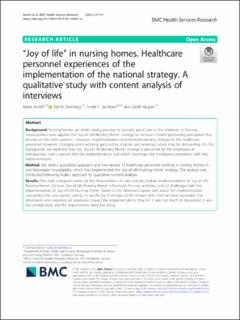| dc.contributor.author | Andre, Beate | |
| dc.contributor.author | Grønning, Kjersti | |
| dc.contributor.author | Jacobsen, Frode F. | |
| dc.contributor.author | Haugan, Gørill | |
| dc.date.accessioned | 2021-09-27T06:38:55Z | |
| dc.date.available | 2021-09-27T06:38:55Z | |
| dc.date.created | 2021-08-05T20:41:44Z | |
| dc.date.issued | 2021 | |
| dc.identifier.citation | BMC Health Services Research. 2021, 21, . | en_US |
| dc.identifier.issn | 1472-6963 | |
| dc.identifier.uri | https://hdl.handle.net/11250/2783574 | |
| dc.description.abstract | Background
Nursing homes are under strong pressure to provide good care to the residents. In Norway, municipalities have applied the ‘Joy-of-Life-Nursing-Home’ strategy to increase a health-promoting perception that focuses on the older persons` resources. Implementations represent introducing changes to the healthcare personnel; however, changing one’s working approaches, routines and working culture may be demanding. On this background, we explored how the ‘Joy-of-Life-Nursing-Home’ strategy is perceived by the employees in retrospective, over a period after the implementation and which challenges the employees experience with this implementation.
Method
We used a qualitative approach and interviewed 14 healthcare personnel working in nursing homes in one Norwegian municipality, which had implemented the ‘Joy-of-Life-Nursing-Home’ strategy. The analysis was conducted following Kvale’s approach to qualitative content analysis.
Results
The main categories were: (a) the characteristics of care activities before implementations of ‘Joy-of-Life-Nursing-Home’, (b) how ‘Joy-of-Life-Nursing-Home’ influenced the care activities, and (c) challenges with the implementation of ‘Joy-of-Life-Nursing-Home’. Some of the informants spoke well about the implementation concerning the care quality stating “to see the joy in the eyes of the resident then I feel we have succeeded”. For informants who experienced resistance toward the implementation, they felt it was too much to document, it was too complicated, and the requirements were too many.
Conclusions
Quality of care seems to have increased after the implementation, as perceived by the informants. Nevertheless, the fact that the informants seemed to be divided into two different groups related to their main perspective of the implementation is concerning. One group has positive experiences with the implementations process and the benefits of it, while the other group focuses on lack of benefits and problems with the implementation process. To understand what facilitates and hinders the implementation, research on contextual factors like work environment and leadership is recommended. | en_US |
| dc.language.iso | eng | en_US |
| dc.publisher | BioMed Central Ltd. | en_US |
| dc.rights | Navngivelse 4.0 Internasjonal | * |
| dc.rights.uri | http://creativecommons.org/licenses/by/4.0/deed.no | * |
| dc.title | "Joy of life” in nursing homes. Healthcare personnel experiences of the implementation of the national strategy. A qualitative study with content analysis of interviews | en_US |
| dc.type | Peer reviewed | en_US |
| dc.type | Journal article | en_US |
| dc.description.version | publishedVersion | en_US |
| dc.source.volume | 21 | en_US |
| dc.source.journal | BMC Health Services Research | en_US |
| dc.source.issue | 771 | en_US |
| dc.identifier.doi | 10.1186/s12913-021-06801-w | |
| dc.identifier.cristin | 1924252 | |
| dc.relation.project | Norges forskningsråd: 238331 | en_US |
| dc.relation.project | Norges forskningsråd: 309812 | en_US |
| dc.relation.project | Norges forskningsråd: 320648 | en_US |
| dc.relation.project | Norges forskningsråd: 188928 | en_US |
| dc.relation.project | Norges forskningsråd: 288256 | en_US |
| dc.source.articlenumber | 771 | en_US |
| cristin.ispublished | true | |
| cristin.fulltext | original | |
| cristin.qualitycode | 2 | |

